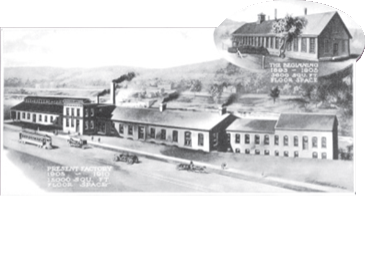Air Compressor Buying Guide
With a seemingly endless variety of air-powered tools manufactured for everything from home craft projects to industrial stone fabrication, pneumatic tool requirements and compressor configurations can range widely. If you are considering the purchase of a Trow & Holden pneumatic hammer, there are a few things to keep in mind to ensure you have an adequate source of compressed air to power your tool.
Choosing the air compressor that is right for you is really a matter of how it will be used, budget, and personal preference. While this document is intended to help you find an air compressor best suited for your needs, don’t forget to keep in mind the nature of your work and any limiting factors, such as access to electricity, ventilation, portability, and noise.
Air Compressor Basics
There are three primary specifications to keep in mind when shopping for an air compressor.
Air Supply
Trow & Holden pneumatic tools require an air flow of approximately 3–8 CFM (cubic feet per minute) at 90–100 psi (pounds per square inch), which will vary based on the size of your air tool. You will want to make sure the compressor’s output and duty cycle will allow you to take advantage of your air tool’s full range of power. Remember, too much air cannot damage your Trow & Holden pneumatic hammer.
Tank Size
Another important consideration is the compressor’s tank size. Trow & Holden pneumatic hammers run on a constant flow of air — unlike more common air-powered tools, which only require frequent bursts of air. This means your Trow & Holden air hammer will deplete its air supply quickly. We generally recommend a compressor with at least 20 gallons of air storage capacity.
Compressor Configuration
Lastly, think about whether or not you want to use compressed air to power other types of air tools, such as grinders, drills or polishers. Running multiple tools at the same time can significantly increase the amount of air needed to power your tools. When possible, consider two-stage compressors, which are most appropriate for powering pneumatic tools with high air consumption.
Features That Make A Difference
- Well-protected and conveniently located control panel and gauges provide easy access.
- A heavy-duty electric motor with manual reset protects against overload.
- Electric start systems with built-in air pressure release create less chance for tripping circuits upon startup.
- Two air outlets enable dual-tool operation.
- Ball valve tank drains allow easy draining with a simple quarter turn.
- Two-stage compressors are most appropriate for powering reciprocating or rotary pneumatic tools and can fill large air tanks with less effort.
- Direct-drive, oil-lubricated pump with cast iron cylinder delivers maximum life and performance.
- Belt-drive, oil-lubricated pump with cast iron cylinder operates at lower RPM, extending life and reducing noise.
- Idle control saves fuel when air tanks reach maximum operating pressure.
- Wheels provide easy maneuverability
- While small tanks provide greater portability, the compressor pump will need to cycle more frequently to keep up with demand. Large tanks keep more air on hand, which can reduce wear on the compressor’s pump.
Air Compressor Specifications
All pneumatic tools will require a certain air flow and pressure for optimal performance. While it is important that your compressor’s output meets these specifications, you should also have an understanding of how these basic measurements and compressor features are related:
PSI (Pounds per Square Inch)
This is the measure of air pressure delivered by your compressor. The higher the psi, the further the air can be compressed meaning a larger volume of compressed air can be stored in the tank.
CFM (Cubic Feet per Minute)
This is the volume of air that your compressor can pump in one minute at a specific working pressure. High CFM ratings mean a compressor can provide more air, making higher CFM units more practical for larger applications.
HP (Horsepower)
This is the unit of measurement for the power your compressors motor produces. Higher horsepower engines produce greater psi and are capable of carrying a heavier workload. This can be particularly important if your need for portability limits your compressors tank size.
Tank Size
Compressors with larger tanks (measured in gallons) can supply more air to your tools between duty cycles, which will put less strain on your compressor’s motor and pump. Smaller tanks will increase portability, but output and duty cycle rates should be considered carefully.
To choose a compressor that will meet the requirements for your tools to function properly, use this formula. Select the tool that requires the highest CFM at the highest psi. Then add 50% to the required CFM as a safety margin. For example, if a tool requires 3 CFM at 90 psi, choose a compressor that provides at a minimum 4.5 CFM at 90 psi.
Once you know the volume and pressure requirements you need, your choices can be considered between these main configurations:
- Stationary
Combining maximum capacity and power, these compressors are an ideal source of air for powering your air tools. - Portable
Commonly referred to as wheelbarrow style, these compressors can be found in horizontal or vertical orientations and feature wheels that allow for easy maneuvering and mobility. They generally provide a moderate source of air, particularly when space is limited or portability is a necessity. Most of these compressors feature gasoline-powered motors with high HP ratings, which help compensate for their reduced air storage capacity. However, they require well-ventilated areas where noise is not a problem, and careful attention should be paid to output. - Small/Compact
Twin-stack and pancake-style compressors provide maximum portability. They are generally the most common type of household compressor, and are ideal for roofing, remodeling, car maintenance, and cleanup applications. However, most of these offer limited horsepower and tank capacity, and will not be a sufficient source of air for powering a Trow & Holden pneumatic hammer.
Visit Your Local Dealer
A great resource for finding the right unit is your local power equipment dealer. Remember that an air compressor should be able to safely power all the tools you plan on using, so bring along a list of those tools and their air specifications to share with the dealer. Be sure to start the unit and try the controls. Ask the dealer if he or she has a model that can be test-driven on-site or at home before making a final buying decision.







